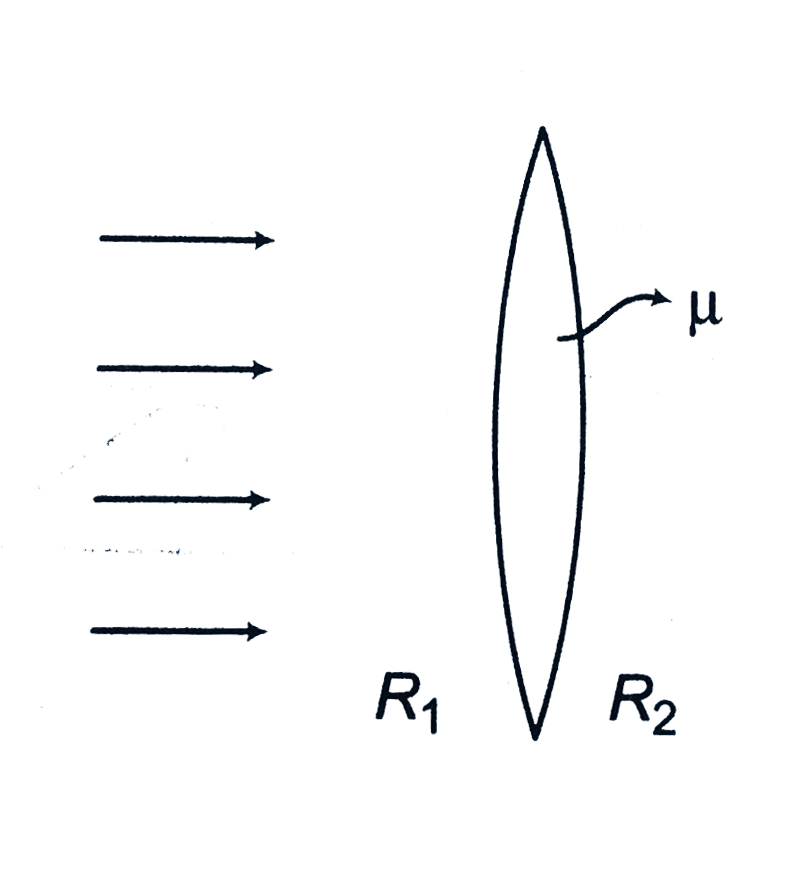A biconvex lens has a radius of curvature of magnitude 20cm. Which one of the following options describes best the image formed of an object of height 2cm place 30cm from the lens ?
Virtual , upright, height =0.5cm
Real, inverted, height =4cm
Real, inverted, height =1cm
Virtual, upright, height =1cm
The correct Answer is:B
To solve the problem of determining the nature and size of the image formed by a biconvex lens, we will follow these steps:
Step 1: Identify the given data
- Radius of curvature (R) = 20 cm
- Object height (h_o) = 2 cm
- Object distance (u) = -30 cm (negative because the object is placed on the same side as the incoming light)
Step 2: Calculate the focal length (f) of the lens
For a biconvex lens, the focal length (f) can be calculated using the radius of curvature. The formula for the focal length of a lens is given by:
f=R2
Since the lens is biconvex, the focal length is positive.
f=20cm2=10cm
Step 3: Use the lens formula to find the image distance (v)
The lens formula is given by:
1f=1v−1u
Rearranging this gives:
1v=1f+1u
Substituting the values:
1v=110+1−30
Finding a common denominator (30):
1v=330−130=230=115
Thus,
v=15cm
Step 4: Calculate the magnification (M)
The magnification (M) is given by the formula:
M=hiho=−vu
Substituting the values:
M=−15−30=12
This means the image height (h_i) can be calculated as:
hi=M⋅ho=12⋅2cm=1cm
Step 5: Determine the nature of the image
Since the magnification is positive, this indicates that the image is virtual and upright.
Conclusion
The image formed is virtual, upright, and has a height of 1 cm.
Summary of the Answer
- Nature of Image: Virtual and upright
- Height of Image: 1 cm
- Radius of curvature (R) = 20 cm
- Object height (h_o) = 2 cm
- Object distance (u) = -30 cm (negative because the object is placed on the same side as the incoming light)
For a biconvex lens, the focal length (f) can be calculated using the radius of curvature. The formula for the focal length of a lens is given by:
f=R2
Since the lens is biconvex, the focal length is positive.
f=20cm2=10cm
The lens formula is given by:
1f=1v−1u
Rearranging this gives:
1v=1f+1u
Substituting the values:
1v=110+1−30
Finding a common denominator (30):
1v=330−130=230=115
Thus,
v=15cm
The magnification (M) is given by the formula:
M=hiho=−vu
Substituting the values:
M=−15−30=12
This means the image height (h_i) can be calculated as:
hi=M⋅ho=12⋅2cm=1cm
Since the magnification is positive, this indicates that the image is virtual and upright.
The image formed is virtual, upright, and has a height of 1 cm.
- Nature of Image: Virtual and upright
- Height of Image: 1 cm
Topper's Solved these Questions
- BOOK - A2ZCHAPTER - GEOMETRICAL OPTICSEXERCISE - Assertion Reason15videos
GEOMETRICAL OPTICS
- BOOK - A2ZCHAPTER - GEOMETRICAL OPTICSEXERCISE - Section D - Chapter End Test30videos
GEOMETRICAL OPTICS
- BOOK - A2ZCHAPTER - GEOMETRICAL OPTICSEXERCISE - Section B - Assertion Reasoning19videos
GEOMETRICAL OPTICS
- BOOK - A2ZCHAPTER - ELECTROMAGNETIC WAVES AND COMMUNICATION SYSTEM EXERCISE - Section D - Chapter End Test30videos
ELECTROMAGNETIC WAVES AND COMMUNICATION SYSTEM
- BOOK - A2ZCHAPTER - MAGNETISM AND MATTEREXERCISE - Section D - Chapter End Test30videos
MAGNETISM AND MATTER
Similar Questions
A biconvex lens (μ=1.5) has radius of curvature 20cm (both).
find its focal length.
 View Solution
View SolutionA biconvex lens has equal radii of curvature of 20 cm for each face and is made of material of refractive index 1.5. An object of 6 cm height is placed at a distance of 10 cm from the lens. Find the position, nature and size of the image.
View Solution
Knowledge Check
- Question 1 - Select One
A biconvex lens (n = 1.5) has a radius of curvature of magnitude 20 cm. Which one of the following options describe best the image formed of an object of height 2 cm place 30 cm from the lens?
Areal, inverted, height = 1cmBvirtual, upright, height = 1 cmCvirtual, upright, height = 0.5 cmDreal, inverted, height = 4 cm - Question 2 - Select One
A biconvex lens has a radius of curvature of magnitude 20cm. Which one of the following options describes best the image formed of an object of height 2cm place 30cm from the lens ?
AVirtual, upright, height = 1 cmBVirtual, upright, height = 0.5 cmCReal, inverted, height = 4 cmDReal, inverted, height = 1cm - Question 3 - Select One
An object is placed 30.0 cm from a convex spherical mirror with radius of curvature 40.0 cm.Which one of the following phrases best describes the image?
AVirtual and located at infinityBVirtual and located 12 cm from the mirrorCReal and located 12 cm from the mirrorDVirtual and located 17 cm from the mirror
A biconvex lens has radii of curvature 20 cm and 40cm. The refractive index of the material of the lens is 1.5. An object is placed 40cm in front of the lens. Calculate the psition of the image.
View SolutionThere is a glass (μ=1.5) biconvex lens of radius of curvature 5 cm and thickness of the lens is also 5 cm. An object is placed at a distance 20 cm from the front surface of lens. Locate its final image.
View SolutionA biconvex lens is made of glass with μ=1.52. Each surface has a radius of curvature equal to 30cm. An object of height 3cm is placed 14cm from the lens. Find the focal length of the lens and the position and size of image.
View SolutionAn object is placed 30cm to the left of a diverging lens whose focal length is of magnitude 20cm. Which one of the following correctly states the nature and position of the virtual image formed ?
View SolutionA convex lens of focal length 15 cm is placed on a plane mirror. An object is placed at 30 cm from the lens. The image is
View Solution

